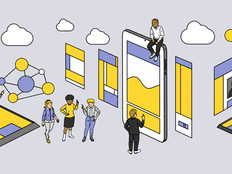Adobe Creative Cloud Gives Students an Edge in the Classroom and Beyond
Colleges and universities are increasingly called upon to provide new value to their students. The purpose of higher education will always be fostering positive and successful academic experiences. But institutions must also equip students with the skills to stand out in the workforce after graduation.
Many of today’s employers are looking for candidates who possess digital literacy and creative skills. Few tools boost these abilities better than Adobe Creative Cloud, which can be used across academic disciplines and degrees. Adobe recently partnered with Civitas Learning and LinkedIn to assess how Creative Cloud can improve student outcomes and career trajectories. Here are some of the findings from Adobe’s report, which was pulled from customer-provided data from fall 2019, spring 2020 and fall 2020.
DISCOVER: Adobe products and solutions for higher ed.
Creative Cloud Leads to Better Student Outcomes
Civitas and Adobe researched the impact that using Creative Cloud had on postsecondary students. They found that when Adobe was integrated into teaching and coursework, student outcomes improved. Students earned A’s and B’s at a 4.5 percent higher rate, had 8 percent higher grades overall and saw a 0.2 percent average increase in GPA. The study also saw Black and African American students earn course grades that were 2.2 times higher than average, while first-term students and the lowest-performing students increased their grades by a respective 2.4 and 1.7 times.
These results are driven, in part, by the increased engagement students feel due to the creativity that Adobe products foster. As Elena Camargo, a senior lecturer at the University of Texas at San Antonio (UTSA), tells the Adobe Blog, “When you give students more freedom and allow them to explore a project creatively, they become more invested in whatever they’re doing.”
That creative freedom can be nurtured via the stable of tools that Creative Cloud provides to tackle assignments. There are also more concrete benefits. “The fact that you can complete an assignment using one of five different tools really helps the students get exposure and learn problem-solving and decide which tool makes the most sense for a particular use,” says Matthew Evins, director of academic technology at Austin Community College in Austin, Texas.
He uses a history assignment as an example. “Students could be asked to describe and present a timeline of events that happened over a certain century or a certain era. Students typically might do that with a PowerPoint, but you could use things like Adobe Illustrator to create an infographic. You could do something with motion graphics with After Effects or Premiere Pro,” he says. “It takes that same learning assignment to the next level and builds up the student’s technical competencies as they look to enter the workforce.”
MORE ON ADOBE: How Adobe Sign improves remote work for higher ed.
Creative Skills Give Career Trajectories a Boost
Building up technical competency with Creative Cloud can help students build a more successful academic life — and a more successful post-grad one as well. As Melissa Vito, vice provost for academic innovation at UTSA, tells Adobe, “the most important skill for students in any career is digital literacy.” Employers don’t just prefer it; they require it. Evins has seen this firsthand in Austin. “What we have found is that a lot of employers in the Austin area really value individuals who have a technology skill set, even if they’re not programmers,” he says.
The Adobe report notes that digital literacy paired with creative strategies is what can truly affect a career trajectory. The report reveals that creativity ranks No. 1 among the most in-demand workforce skills and that it has led to a 78 percent increase in hiring those with creative abilities over the past two years. Recent grads with creative skills on their resumes see starting salaries 16 percent higher than those of their peers, and could ultimately see salary increases two to three times higher than their peers throughout their careers.
EXPLORE: Adobe Creative Cloud empowers students with digital literacy skills.
Creative skills also translate into creative problem-solving skills in the workplace. “You have tools to actually map things out in front of you. Being able to work in that three-dimensional landscape is very attractive to employers,” says John Moore, an associate professor of radio, television and film at Austin Community College. “If you’re the only one in your group who knows how to do more than talk — doing mock-ups or drafts of a project or giving presentations in a way where you can make things materialize outside your head — that makes you a lot more indispensable on a team.”
In short, the Adobe report uncovers what postsecondary educators continue to discover: Creative Cloud can improve lives in the classroom and beyond. “It’s a tool that provides gateway opportunities for students,” Evins says.
Brought to you by:










